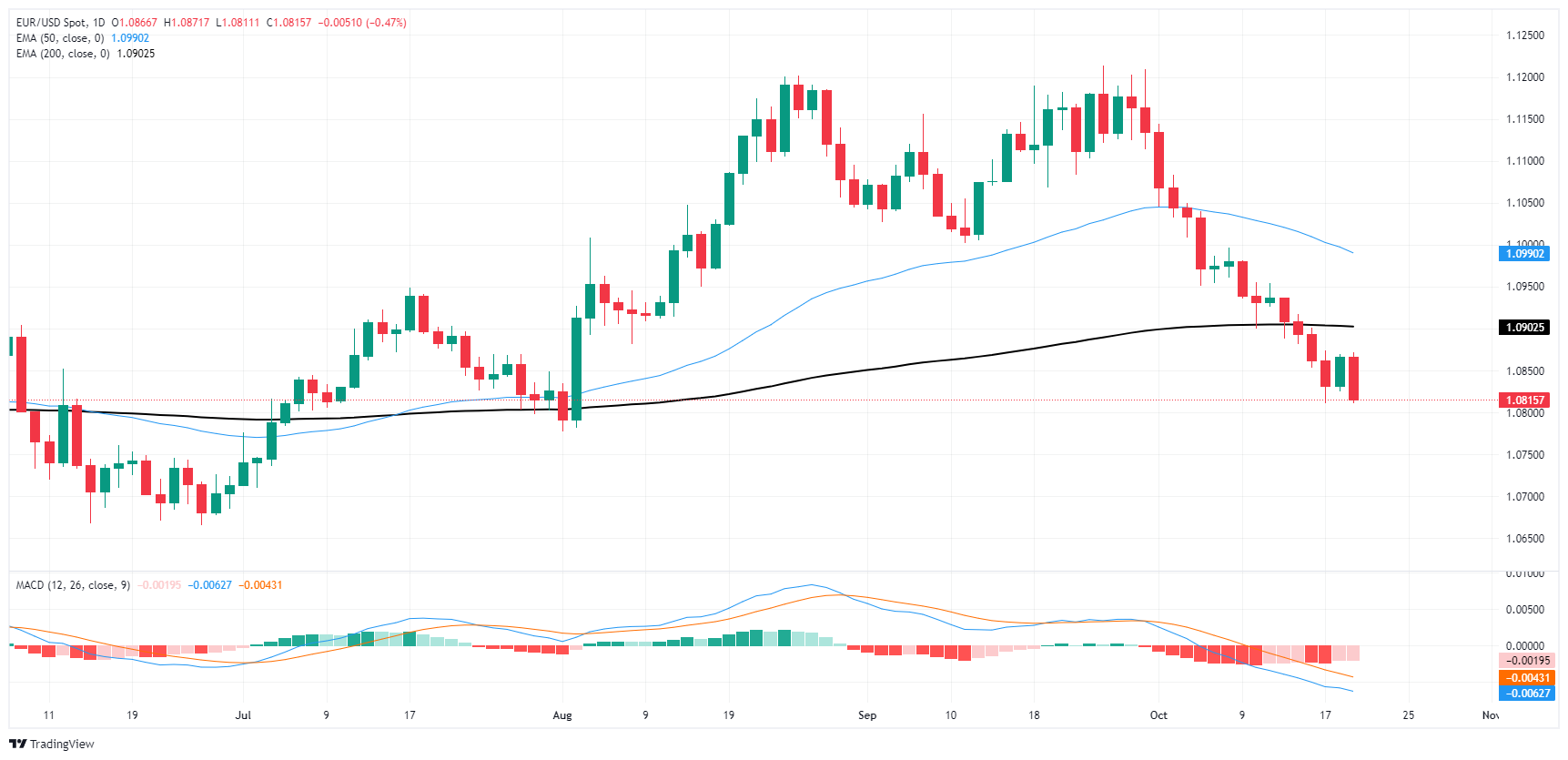EUR/USD grinds closer to 1.08 in Monday fallback


- EUR/USD shed nearly half of a percent to open another trading week.
- Markets pivoted back into the Greenback on renewed skepticism on the pace of rate cuts.
- Heavy appearances from central bank member due throughout the week.
EUR/USD fumbled on Monday, kicking off a new trading week with a downside push as price action waffled back into familiar 12-week lows just above the 1.0800 handle. Markets remain apprehensive on the future pace of rate cuts, specifically from the Federal Reserve (Fed), and Purchasing Managers Index (PMI) activity figures due later in the week will give investors a glimpse at the shape of the global economy in the coming weeks.
European Central Bank (ECB) President Christine Lagarde is slated to make several appearances this week. The ECB head’s key public outing will be on Wednesday when ECB President Lagarde will speak on Europe’s current financial challenges at the Atlantic Council in Washington DC.
Global PMI figures are due for a rolling release on Thursday. Markets have high expectations for pan-EU PMI survey results, with median market forecasts calling for a slight uptick in October’s EU Services PMI to 51.6 from September’s 51.4.
EUR/USD price forecast
The EUR/USD pair continues to trade with a bearish bias, currently hovering around 1.0815 after a decisive break below both the 50-day EMA at 1.0990 and the 200-day EMA at 1.0902. The price action confirms that the bears remain firmly in control as the pair consolidates near its recent lows. The inability to regain ground above the 200-day EMA indicates that downside momentum is likely to persist. Immediate support rests at 1.0800, with further declines possibly targeting the 1.0700 region if bearish pressure intensifies.
The MACD indicator further reinforces the bearish outlook, with both the MACD line and signal line in negative territory, and the histogram expanding to the downside. This signals increasing bearish momentum, which suggests that any attempts by the bulls to recover could face strong resistance. A sustained move above 1.0900 is required to shift the bias back to neutral, but without a clear bullish catalyst, the path of least resistance remains to the downside in the near term.
EUR/USD daily chart
Euro FAQs
What is the Euro?
The Euro is the currency for the 19 European Union countries that belong to the Eurozone. It is the second most heavily traded currency in the world behind the US Dollar. In 2022, it accounted for 31% of all foreign exchange transactions, with an average daily turnover of over $2.2 trillion a day. EUR/USD is the most heavily traded currency pair in the world, accounting for an estimated 30% off all transactions, followed by EUR/JPY (4%), EUR/GBP (3%) and EUR/AUD (2%).
What is the ECB and how does it impact the Euro?
The European Central Bank (ECB) in Frankfurt, Germany, is the reserve bank for the Eurozone. The ECB sets interest rates and manages monetary policy. The ECB’s primary mandate is to maintain price stability, which means either controlling inflation or stimulating growth. Its primary tool is the raising or lowering of interest rates. Relatively high interest rates – or the expectation of higher rates – will usually benefit the Euro and vice versa. The ECB Governing Council makes monetary policy decisions at meetings held eight times a year. Decisions are made by heads of the Eurozone national banks and six permanent members, including the President of the ECB, Christine Lagarde.
How does inflation data impact the value of the Euro?
Eurozone inflation data, measured by the Harmonized Index of Consumer Prices (HICP), is an important econometric for the Euro. If inflation rises more than expected, especially if above the ECB’s 2% target, it obliges the ECB to raise interest rates to bring it back under control. Relatively high interest rates compared to its counterparts will usually benefit the Euro, as it makes the region more attractive as a place for global investors to park their money.
How does economic data influence the value of the Euro?
Data releases gauge the health of the economy and can impact on the Euro. Indicators such as GDP, Manufacturing and Services PMIs, employment, and consumer sentiment surveys can all influence the direction of the single currency. A strong economy is good for the Euro. Not only does it attract more foreign investment but it may encourage the ECB to put up interest rates, which will directly strengthen the Euro. Otherwise, if economic data is weak, the Euro is likely to fall. Economic data for the four largest economies in the euro area (Germany, France, Italy and Spain) are especially significant, as they account for 75% of the Eurozone’s economy.
How does the Trade Balance impact the Euro?
Another significant data release for the Euro is the Trade Balance. This indicator measures the difference between what a country earns from its exports and what it spends on imports over a given period. If a country produces highly sought after exports then its currency will gain in value purely from the extra demand created from foreign buyers seeking to purchase these goods. Therefore, a positive net Trade Balance strengthens a currency and vice versa for a negative balance.






.jpg)